
Dada or Dadaism was an art movement of the European avant-garde in the early 20th century, with early centres in Zürich, Switzerland, at the Cabaret Voltaire, founded by Hugo Ball with his companion Emmy Hennings, and in Berlin in 1917. New York Dada began c. 1915, and after 1920 Dada flourished in Paris. Dadaist activities lasted until the mid 1920s.

Édouard Manet was a French modernist painter. He was one of the first 19th-century artists to paint modern life, as well as a pivotal figure in the transition from Realism to Impressionism.
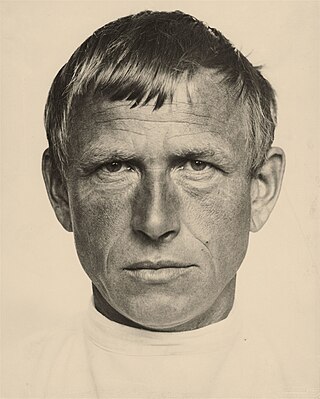
Wilhelm Heinrich Otto Dix was a German painter and printmaker, noted for his ruthless and harshly realistic depictions of German society during the Weimar Republic and the brutality of war. Along with George Grosz and Max Beckmann, he is widely considered one of the most important artists of the Neue Sachlichkeit.

Modern art includes artistic work produced during the period extending roughly from the 1860s to the 1970s, and denotes the styles and philosophies of the art produced during that era. The term is usually associated with art in which the traditions of the past have been thrown aside in a spirit of experimentation. Modern artists experimented with new ways of seeing and with fresh ideas about the nature of materials and functions of art. A tendency away from the narrative, which was characteristic of the traditional arts, toward abstraction is characteristic of much modern art. More recent artistic production is often called contemporary art or postmodern art.

Max Carl Friedrich Beckmann was a German painter, draftsman, printmaker, sculptor, and writer. Although he is classified as an Expressionist artist, he rejected both the term and the movement. In the 1920s, he was associated with the New Objectivity, an outgrowth of Expressionism that opposed its introverted emotionalism. Even when dealing with light subject matter like circus performers, Beckmann often had an undercurrent of moodiness or unease in his works. By the 1930s, his work became more explicit in its horrifying imagery and distorted forms with combination of brutal realism and social criticism, coinciding with the rise of nazism in Germany.

George Grosz was a German artist known especially for his caricatural drawings and paintings of Berlin life in the 1920s. He was a prominent member of the Berlin Dada and New Objectivity groups during the Weimar Republic. He emigrated to the United States in 1933, and became a naturalized citizen in 1938. Abandoning the style and subject matter of his earlier work, he exhibited regularly and taught for many years at the Art Students League of New York. In 1959 he returned to Berlin, where he died shortly afterwards.

Oskar Kokoschka was an Austrian artist, poet, playwright, and teacher best known for his intense expressionistic portraits and landscapes, as well as his theories on vision that influenced the Viennese Expressionist movement.

Lucian Michael Freud was a British painter and draughtsman, specialising in figurative art, and is known as one of the foremost 20th-century English portraitists. He was born in Berlin, the son of Jewish architect Ernst L. Freud and the grandson of Sigmund Freud. Freud got his first name "Lucian" from his mother in memory of the ancient writer Lucian of Samosata. His family moved to England in 1933, when he was 10 years old, to escape the rise of Nazism. He became a British naturalized citizen in 1939. From 1942 to 1943 he attended Goldsmiths' College, London. He served at sea with the British Merchant Navy during the Second World War.
Events from the year 1925 in art.

Charles Henry Buckius Demuth was an American painter who specialized in watercolors and turned to oils late in his career, developing a style of painting known as Precisionism.

The New Objectivity was a movement in German art that arose during the 1920s as a reaction against expressionism. The term was coined by Gustav Friedrich Hartlaub, the director of the Kunsthalle in Mannheim, who used it as the title of an art exhibition staged in 1925 to showcase artists who were working in a post-expressionist spirit. As these artists—who included Max Beckmann, Otto Dix, George Grosz, Christian Schad, Rudolf Schlichter and Jeanne Mammen—rejected the self-involvement and romantic longings of the expressionists, Weimar intellectuals in general made a call to arms for public collaboration, engagement, and rejection of romantic idealism.

Christian Schad was a German painter and photographer. He was associated with the Dada and the New Objectivity movements. Considered as a group, Schad's portraits form an extraordinary record of life in Vienna and Berlin in the years following World War I.
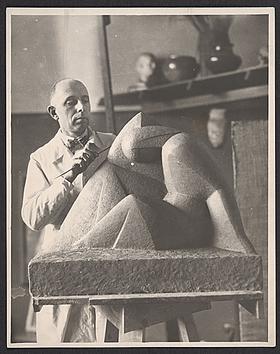
Arnold Rönnebeck was a German-born American modernist artist and museum administrator. He was a vital member of both the European and American avant-garde movements of the early twentieth century before settling in Denver, Colorado. Rönnebeck was a sculptor and painter, but is best known for his lithographs that featured a range of subjects including New York cityscapes, New Mexico and Colorado landscapes and Native American dances.
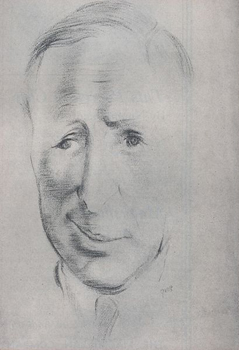
Thomas Craven was an American author, critic and lecturer, who promoted the work of American Regionalist painters, Thomas Hart Benton, John Steuart Curry and Grant Wood, among others. He was known for his caustic comments and being the "leading decrier of the School of Paris."
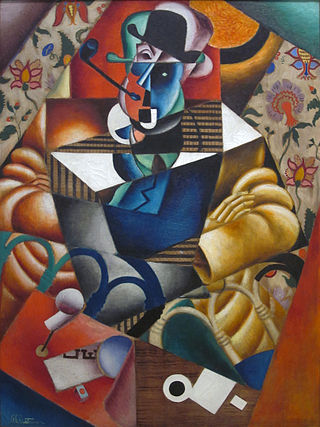
Man with Pipe is a Cubist painting by the French artist Jean Metzinger. It has been suggested that the sitter depicted in the painting represents either Guillaume Apollinaire or Max Jacob. The work was exhibited in the spring of 1914 at the Salon des Indépendants, Paris, Champ-de-Mars, March 1–April 30, 1914, no. 2289, Room 11. A photograph of Le Fumeur was published in Le Petit Comtois, 13 March 1914, for the occasion of the exhibition. In July 1914 the painting was exhibited in Berlin at Herwarth Walden’s Galerie Der Sturm, with works by Albert Gleizes, Raymond Duchamp-Villon and Jacques Villon.
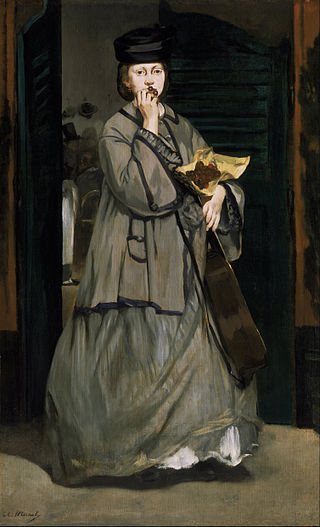
Street Singer is a circa 1862 oil-on-canvas painting by Édouard Manet depicting a female street musician standing near the entrance to a cabaret.

Max Herrmann-Neisse was a German expressionist writer.
Charlotte Weidler (1895–1983) was a German art dealer, curator and art historian. Her dealings concerning artworks from the collections of Paul Westheim and Alfred Flechtheim during the Nazi–era have been the focus of several high-profile lawsuits.

Metropolis is an oil on canvas painting by the German artist George Grosz, executed in 1916–1917. It belongs to the collection of the Thyssen-Bornemisza Museum in Madrid.

The Love Sick is an oil on canvas painting by the German expressionist painter George Grosz, executed in 1916. The unsigned work is held at the Kunstsammlung Nordrhein-Westfalen, in Düsseldorf. It was bought from the New York gallery owner Richard L. Feigen, in 1979.


















